Going to a restaurant in a foreign country when you don’t speak the language fluently can be unnecessarily stressful for several reasons:
- You don’t know French etiquette: how should I behave? How do things work? How do I address the waitress? Should I leave a tip?
- You don’t know the language: How do I ask for a drink? How do you say “Main course?” What’s the phrase to ask for more bread?
Knowing the basic French restaurant phrases is one thing, but learning about the ins and outs of French dining beforehand will truly take you to the next level.
In this article, we’ll go through the six steps of going to a restaurant, and, for each phase, we’ll list the most common and useful French phrases, as well as the restaurant etiquette and unwritten rules you need to know. Fasten your napkin, and let’s dive right into it.
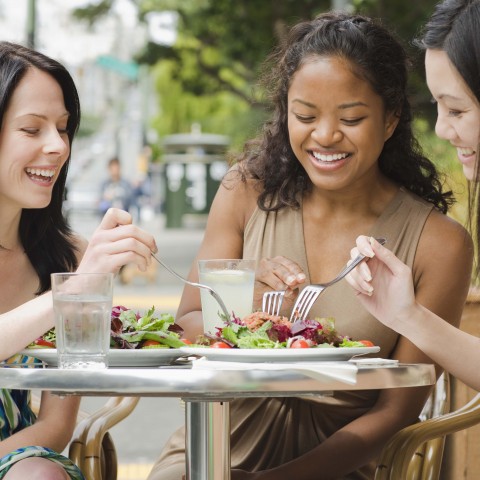
Un restaurant entre amies (“A restaurant with friends”)
 Table of Contents
Table of Contents
- Booking a Restaurant
- Entering a Restaurant
- Time for Drinks
- Food on the Table
- During the Meal
- Here Comes the Bill
- Conclusion
1. Booking a Restaurant
A- Should I book? Can I book?
Booking a restaurant is rarely an obligation in France, and you can almost always show up unannounced. Without booking, there’s no guarantee you’ll find a table, though, and in the most popular joints, you may be in for some discouragingly long lines.
There must be some upper-class restaurants that only accept customers with a booking, but I’ve never seen it myself. On the other hand, don’t be surprised if some restaurants don’t take reservations. They prefer to stick to the “first come, first served” rule and won’t block tables.
B- When should I book?
Cheap brasseries and mid-range restaurants with strategic locations can get extremely packed for lunch during the week, as workers from the neighboring companies all flock there at the same time during their synchronized lunch breaks. As a result, booking for lunch is generally a good idea.
Other restaurants, especially in the city center, are very popular dinner options and can attract long lines. If you know that you’re aiming at some sort of iconic or renowned place, it’s better to book in advance.
C- How do I book?
Some restaurants have their own booking system on their official website. Some use thefork.fr or other similar third-party services. In most cases, you can simply make a phone call. Booking information and phone numbers are usually available on Maps.
D- Conversation Example
Here is a phone conversation between a client and a restaurant employee:
| Bonjour, Restaurant “Le Loup”, comment puis-je vous aider ? (“Hello, “Le loup” restaurant, how may I help you?”) Bonjour, je voudrais réserver une table pour demain soir. (“Hello, I would like to book a table for tomorrow evening.”) Bien sûr. Combien de personnes ? (“Certainly. How many people?”) Quatre personnes. (“Four people.”) Vous voudriez manger à l’intérieur ou en terrasse ? (“Would you like to eat inside or on the terrace?”) En terrasse, si c’est possible. (“On the terrace if that’s possible.”) D’accord. À quelle heure souhaitez-vous réserver ? (“Okay. What time would you like to book?”) À 20h30. (“At 8:30 pm.”) Pas de problème. Demain soir à 20h30, 4 personnes en terrasse. C’est réservé. (“No problem. Tomorrow night at 8:30, 4 people on the terrace. It’s booked.”) Parfait. Merci beaucoup ! Au revoir. (“That’s fine. Thank you very much! Goodbye.”) |
It is useful to know all possible questions, but with experience, you can cut through a lot of this back and forth and simply ask:
| Bonjour, je voudrais réserver pour ce midi à 12h40, pour six personnes. (“Hello, I would like to make a reservation for lunch at 12:40 for six people.”) |
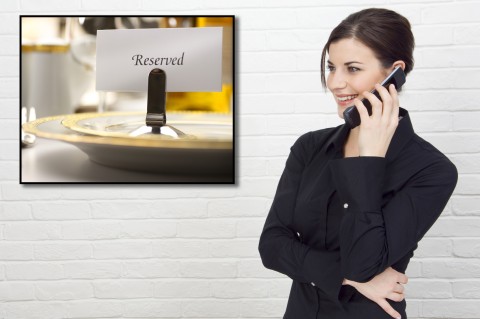
Réserver une table (“To book a table”)
2. Entering a Restaurant
If you already know the menu and even booked a table, this part of the process will be as simple as introducing yourself at the entrance :
| Bonjour, j’ai une réservation au nom de Jack Bauer. (“Hello, I have a reservation under the name of Jack Bauer.”) Bonsoir, j’ai réservé au nom de Jack Bauer, pour six personnes. (‘Good evening, I have a reservation under the name of Jack Bauer, for six people.’) |
And you will be shown your table.
If you’re not that prepared, there are a few things you need to know when choosing a restaurant:
- What’s on the menu?
- How much is the food?
- Does it look pretty enough?
A- Can I See the Menu?
Many restaurants have their menu displayed outside, on a sign, or in the restaurant’s window. This is convenient if you want to quietly check your options before entering, as many people are too shy to leave once they set foot inside the premises.
If you can’t find any menu, I would simply advise that you ask for it before sitting down and, if you don’t like what you see, just give it back, thank them politely, and leave. No sane person will take offense, and it’s not considered bad etiquette.
| Est-ce que je peux voir le menu, s’il vous plaît ? (“Can I please see the menu?”) Merci, bonne soirée ! (“Thank you, have a good evening!”) |
B- Typical Questions and Answers
Once you enter a restaurant, the staff may ask you some questions:
| Bonsoir, c’est pour manger ? (“Good evening, are you here to eat?”) Please, refrain from answering, “No, I’m here to play squash.” It’s not as stupid a question as it sounds. Most restaurants also serve drinks, and it’s customary to ask the question so they can place you accordingly. Oui. (“Yes.”) Non, juste pour prendre un verre. (“No, just to have a drink.”) |
| Vous souhaitez manger à l’intérieur ou en terrasse ? (“Would you like to eat inside or on the terrace?”) À l’intérieur, s’il vous plaît. (“Inside, please.”) |
| Combien de personnes ? (“How many people?”) Pour deux personnes ? (“For two people?”) Once again, it might be tempting to answer, “No, the third one is hiding under my coat,” but this poor employee is merely doing their job! You might be expecting more friends to join, and the waiter needs to know what table size you need. Pour trois personnes. (“For three people.”) |
- ➜ You can find more words and practice your pronunciation with our vocabulary list on Restaurants, on FrenchPod101.
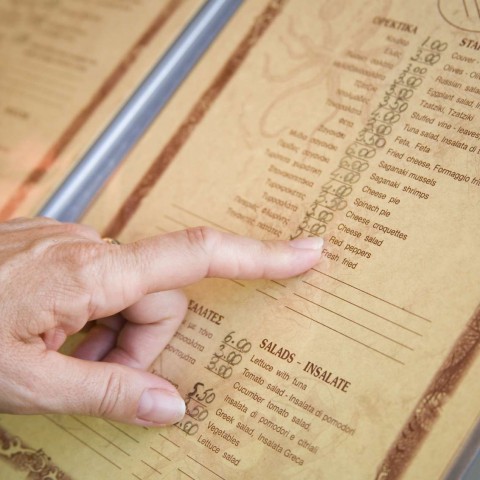
Le menu (“The menu”)
3. Time for Drinks
Now is the most exciting time! There’s delicious food on the menu, and you’re one order away from having it on your table. No time to get nervous: ordering is usually fairly simple as you can refer to the menu and ask for more information if you’re not familiar with some of the dishes.
But, first, more restaurants will ask you if you want an apéritif. This French word stands for the alcoholic beverage served before a meal to stimulate the appetite. It is usually dry rather than sweet and might come with dry nuts, olives, or breadsticks if you’ve picked a cool place.
A- Ordering Apéritifs
The apéritif drinks are often listed in a specific section of the menu and are not mandatory. If you don’t feel like having one, simply decline it. It’s also perfectly fine not to have one when you’re among other people, and they order some apéritifs.
Also, keep in mind that restaurants generally make the most margin on drinks, so they’ll never fail to ask you whether you want apéritifs, wine, beer, bottled water, digestifs, and so on.
| Est-ce que vous voulez des apéritifs ? (“Do you want to order apéritifs ?”) Je voudrais un pastis, s’il vous plaît. (“I would like a pastis, please.”) Non merci. (“No, thank you.”) |
B- Ordering Drinks
Some restaurants phrase it differently and ask if you want to order some drinks. This could happen as soon as you’re seated when you have no idea what’s on the drink menu. You could order an apéritif but also order something to drink with your food, such as table wine or beer.
| Qu’est-ce que vous voulez boire ? (“What do you want to drink?”) Est-ce qu’il y aura des boissons ? (“Will there be drinks?”) Je voudrais un demi de blonde, s’il vous plaît. (“I’d like a half-pint of blond beer, please.”) Non merci. (“No, thank you.”) Rien pour moi. (“Nothing for me.”) Peut-être plus tard. (“Maybe later.”) |
C- Free Water Tastes Better
Whatever else you’re having, now is also the best time to order some water.
Tap water is always free in France (by law), and it’s drinkable all over the country. If you’re fine with simple water in a pitcher and not fancy bottled sparkling water, this is the way to go. Bottled water is sold at absurd prices in restaurants, so it’s never worth ordering it when you can have free tap water.
This is an amazing feature of French restaurants, especially if you’re on a budget. And it’s also much more eco-friendly than drinking from a disposable bottle.
To ask for your free water, don’t just ask for water: sneaky waiters could interpret your order as mineral water and charge you for it. Instead, use this phrase:
| Une carafe d’eau s’il vous plaît. (“A jug of water, please.”) Be sure to emphasize the word Carafe (“Jug”). This is what differentiates free water from a paid order of mineral water. And, if you run out, you can refill as much as you need. Est-ce que je pourrais ravoir de l’eau, s’il vous plaît ? (“Can I have more water, please?”) |
- ➜ Feeling thirsty? Head to our free vocabulary list on Drinks, on FrenchPod101.

Prendre l’apéritif (“To have an aperitif”)
4. Food on the Table
Ok, you’ve waited long enough. Let’s put some food on this table!
In most cases, you’ll have a menu right in front of you, but some restaurants do things differently. It may be on a blackboard somewhere on the wall or in the room, and I’ve been to places with digital menus where you scan a QR code and browse it on your phone.
Most inexpensive brasseries or mid-range restaurants have a Menu du jour (“Menu of the day”) or at least a Plat du jour (“Today’s special” but literally: “Dish of the day”), but some dodgy places could spot that you’re a tourist and decide to give you the regular menu that is usually more expensive.
| Quel est le plat du jour ? (“What is today’s special?”) Je voudrais le plat du jour. (“I would like today’s special.”) Je voudrais le menu du jour. (“I would like the menu of the day.”) Je voudrais la formule du midi. (“I would like the lunch menu.”) |
If you need to know more about a specific dish, don’t hesitate to ask:
| La tartiflette, qu’est-ce que c’est ? (“The tartiflette, what it is?”) C’est un plat à base de pommes de terre, avec du fromage et des lardons. (“It is a potato-based dish with cheese and bacon.”) |
Whether you’re ordering from the specials or à la carte, here are a few examples:
| En entrée, je voudrais la salade composée. (“As a starter, I would like the mixed salad.”) Comme plat, je voudrais un steak au poivre. (“As a dish, I would like a steak au poivre.”) En dessert, je voudrais la mousse au chocolat. (“For dessert, I would like the chocolate mousse.”) |
If you have any allergy or a special diet, now is the time to talk about it:
| Je suis allergique aux cacahuètes. (“I’m allergic to peanuts.”) Est-ce que ce plat contient des cacahuètes ? (“Does this dish contain peanuts?”) Avez-vous des plats végétariens ? (“Do you have vegetarian dishes?”) Avez-vous des plats végans ? (“Do you have vegan dishes?”) |
- ➜ For more sentences on how to order in a restaurant, you may want to check our vocabulary list with Useful phrases and vocabulary for ordering food. It’s free on FrenchPod101.
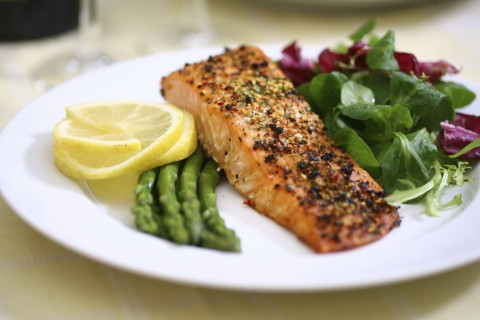
Un filet de saumon (“A salmon filet”)
5. During the Meal
Food has come to the table and is currently traveling toward your stomach. Everything’s going well, but you may have some requests for the waiter, or worse: what if they ask you some questions?
A thoughtful waiter might ask you if everything is going well or if you need anything.
| Est-ce que tout se passe bien ? (“Is everything going well?”) Tout va bien ? (“Is everything okay?”) Oui, très bien, merci ! (“Yes, very good, thank you.”) Est-ce que je pourrais avoir plus de pain, s’il vous plaît ? (“Could I have some more bread, please?”) Je voudrais reprendre un verre de vin, s’il vous plaît. (“I’d like another glass of wine, please.”) Est-ce que vous avez des sauces pour les frites ? (“Do you have some sauce for the fries?”) |
If you need to call for a waiter, try to make eye contact or get their attention with a simple: Excusez-moi (“Excuse me”)
Now it’s time for dessert, isn’t it? You don’t want to miss out on the local delicacies!
| Est-ce que vous prendrez des desserts ? (“Will you have some desserts?”) Vous voulez la carte des desserts ? (“Do you want to see the desserts menu?”) Je voudrais les profiteroles, s’il vous plaît. (“I’d like the profiteroles, please.”) Profiteroles are small balls of soft choux pastry filled with whipped cream or ice cream and covered with hot chocolate sauce. They’re served in heaven and in every good French restaurant. |
It is common for the French to order a coffee after their meal and most waiters will ask if you’d like one:
| Est-ce que vous prendrez un café ? (“Will you have a coffee?”) |
- ➜ Are you missing a fork or a spoon? Make sure to visit our vocabulary list on Utensils and Tableware, on FrenchPod101.
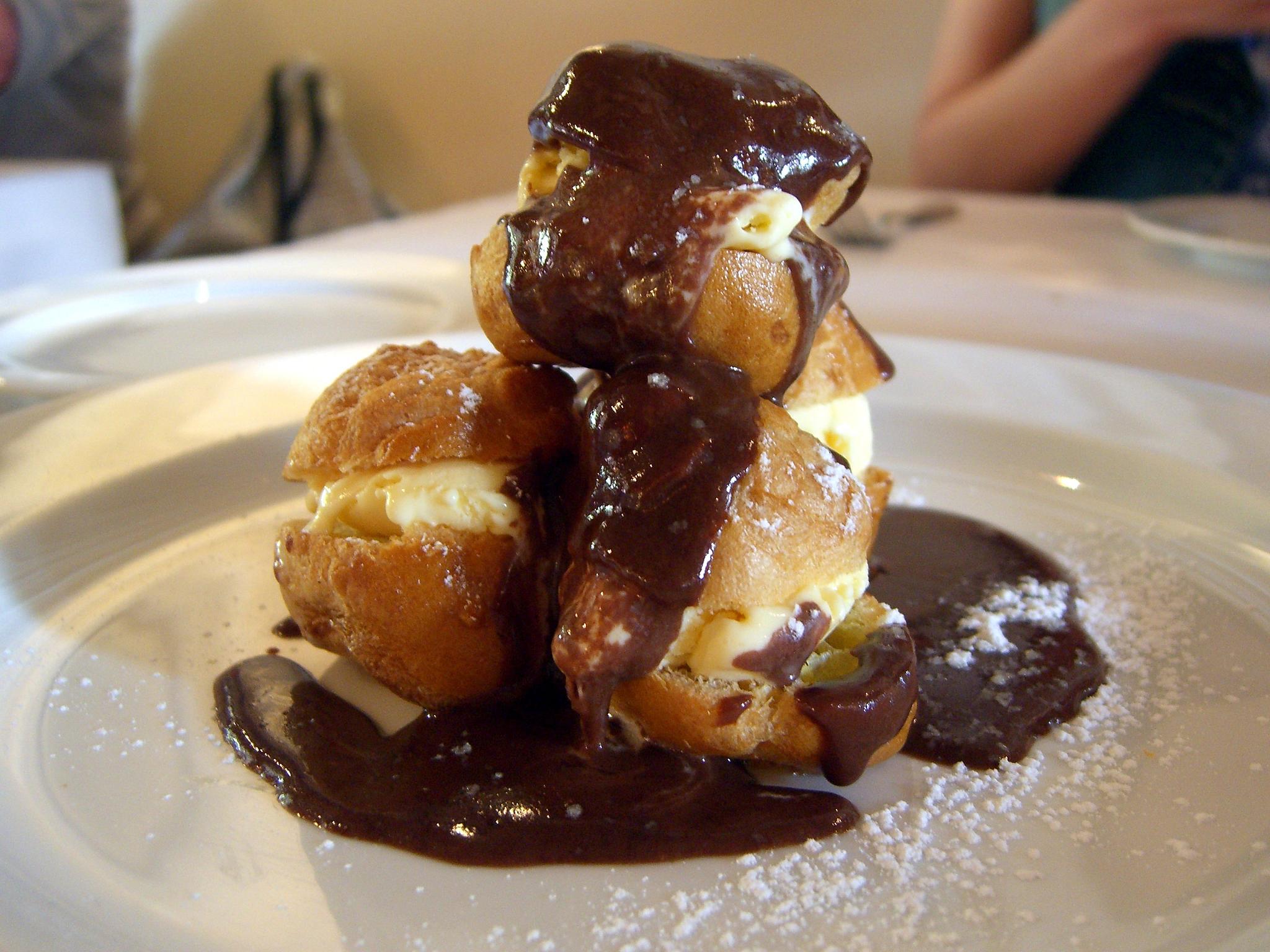
Des profiteroles (“Profiteroles”) (Credit: Annie Smithers Bistrot, shared under CC BY-SA 2.0)
6. Here Comes the Bill
Once you’re done with the main course or with the whole meal, waiters will sometimes ask for your feedback. It’s often just protocol, but you may want to go the extra mile if you really had a great time.
| Tout s’est bien passé ? (“Did everything go well?”) Très bien, merci. (“Very well, thank you.”) C’était délicieux, merci ! (“It was delicious, thank you.”) C’était vraiment excellent. Mes compliments au chef. (“It was really excellent. My compliments to the chef.”) This last one is very formal and may sound awkward if you’ve just had a kebab. |
A- Check Please
When it comes to the bill, there are mainly three types of restaurants:
- Fast food restaurants where you pay at the counter when you order
- Restaurants where you pay at the counter after the meal
- Restaurants where you pay at your table after the meal
When in doubt, look around you for clues or simply ask a waiter:
| Est-ce que je pourrais avoir l’addition, s’il vous plaît ? (“Could I have the bill, please?”) Je vous l’apporte tout de suite. (“I’ll bring it to you right away.”) Vous pouvez régler directement au comptoir. (“You can pay directly at the counter.”) |
Then, when it’s time to pay:
| Vous voulez payer séparément ou ensemble ? (“Do you want to pay separately or together?”) Je vais régler pour tout le monde. (“I will pay for everyone.”) Séparément, s’il vous plaît. (“Separately, please.”) |
B- What About the Tip?
In France, the 15% service fee is always included in the prices as they appear on the menu. Unlike other countries such as Canada or the US, the tip is not seen as something mandatory, and many French don’t tip or only tip when they feel like they have a good reason to do so (outstanding service or amazing food).
French waiters don’t survive on tips, but they’re rarely paid well for a physical and often stressful job, making the tip a welcome bonus to their wage.
Tips are usually left on the table in the form of coins or a bill or in a dedicated tip box at the counter. The average tip would be around 5% of the bill, but there are no strict rules about it, and you should not feel forced. On the other hand, a higher bill is always appreciated.
- ➜ Would you like to see more phrases with recorded examples to work on your pronunciation? Why not stop by our vocabulary list of Key phrases for restaurants on FrenchPod101?
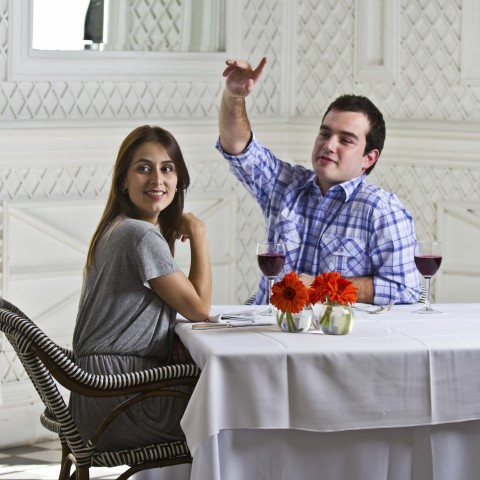
L’addition s’il vous plaît ! (“The bill please!”)
7. Conclusion
In this guide, you have learned everything you need to know when eating in a French restaurant, from making a reservation to apéritifs, drinks, ordering food and desserts, as well as handling the check.
For each step, you need to know the tricks and secret rules, as well as the basic French restaurant phrases. Did we forget some specific situations you’d like to learn more about?
Make sure to explore FrenchPod101, as it has plenty of free resources for you to practice your grammar and learn new words. The vocabulary lists are also a great way to revise the words and learn their pronunciation.
Remember that you can also use our premium service, MyTeacher, to get personal 1-on-1 coaching and have your own private teacher to practice with restaurant phrases and more.
Along with assignments, personalized exercises, and recording audio samples just for you, your teacher will review your work and help improve your pronunciation. Happy learning on FrenchPod101!
About the Author: Born and bred in the rainy north of France, Cyril Danon jumped around from job to job before he left everything behind to wander around the wonders of the world. Now, after quenching his wanderlust for the last few years, he’s eager to share his passion for languages.









